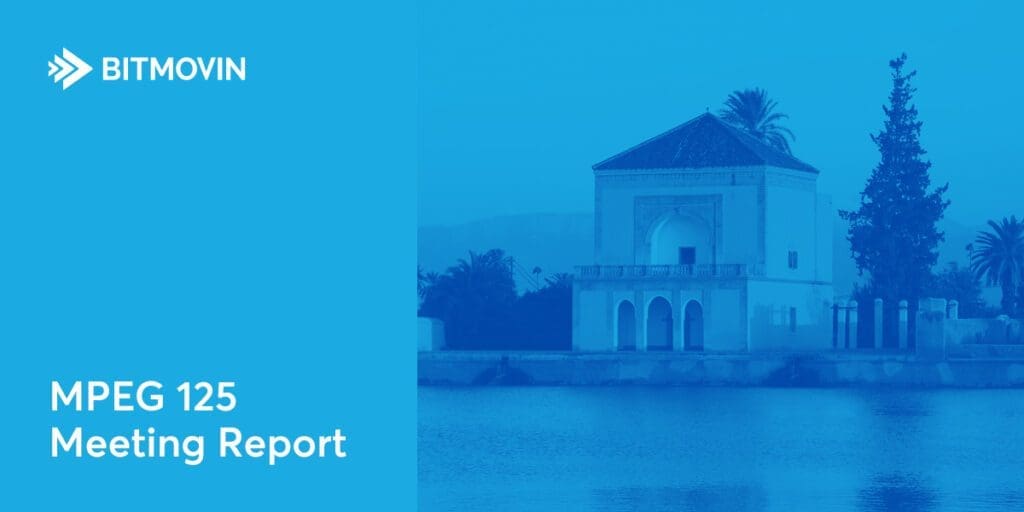The 125th MPEG meeting concluded on January 18, 2019 in Marrakesh, Morocco with the following topics:
- Network-Based Media Processing (NBMP) – MPEG promotes NBMP to Committee Draft stage
- 3DoF+ Visual – MPEG issues Call for Proposals on Immersive 3DoF+ Video Coding Technology
- MPEG-5 Essential Video Coding (EVC) – MPEG starts work on MPEG-5 Essential Video Coding
- ISOBMFF – MPEG issues Final Draft International Standard of Conformance and Reference software for formats based on the ISO Base Media File Format (ISOBMFF)
- MPEG-21 User Description – MPEG finalizes 2nd edition of the MPEG-21 User Description
The corresponding press release of the 125th MPEG meeting can be found here: http://mpeg.chiariglione.org/meetings/125
In this blog post I’d like to focus on those topics potentially relevant for OTT, namely NBMP, EVC, and ISOBMFF.
Network-Based Media Processing (NBMP)
The NBMP standard addresses the increasing complexity and sophistication of media services, specifically as the incurred media processing requires offloading complex media processing operations to the cloud/network to keep receiver hardware simple and power consumption low. Therefore, NBMP standard provides a standardized framework that allows content and service providers to describe, deploy, and control media processing for their content in the cloud. It comes with two main functions: (i) an abstraction layer to be deployed on top of existing cloud platforms (+ support for 5G core and edge computing) and (ii) a workflow manager to enable composition of multiple media processing tasks (i.e., process incoming media and metadata from a media source and produce processed media streams and metadata that are ready for distribution to a media sink). The NBMP standard now reached Committee Draft (CD) stage and the final milestone is targeted for early 2020.
In particular, a standard like NBMP might become handy in the context of 5G in combination with mobile edge computing (MEC) which allows offloading certain tasks to a cloud environment in close proximity to the end user. For OTT, this could enable lower latency and more content being personalized towards the user’s context conditions and needs, hopefully leading to a better quality and user experience.
MPEG-5 Essential Video Coding (EVC)
MPEG-5 EVC clearly targets the high demand for efficient and cost-effective video coding technologies. Therefore, MPEG commenced work on such a new video coding standard that should have two profiles: (i) royalty-free baseline profile and (ii) main profile, which adds a small number of additional tools, each of which is capable, on an individual basis, of being either cleanly switched off or else switched over to the corresponding baseline tool. Timely publication of licensing terms (if any) is obviously very important for the success of such a standard.
The target coding efficiency for responses to the call for proposals was to be at least as efficient as HEVC. This target was exceeded by approximately 24% and the development of the MPEG-5 EVC standard is expected to be completed in 2020.
As of today, there’s the need to support AVC, HEVC, VP9, and AV1; soon VVC will become important. In other words, we already have a multi-codec environment to support and one might argue one more codec is probably not a big issue. The main benefit of EVC will be a royalty-free baseline profile but with AV1 there’s already such a codec available and it will be interesting to see how the royalty-free baseline profile of EVC compares to AV1.
ISO Base Media File Format (ISOBMFF)
The ISOBMFF (ISO/IEC 14496-12) is used as basis for many file (e.g., MP4) and streaming formats (e.g., DASH, CMAF) and as such received widespread adoption in both industry and academia. An overview of ISOBMFF is available here.
The reference software is now available on GitHub (https://github.com/MPEGGroup/isobmff) and a plethora of conformance files are available here: http://download.tsi.telecom-paristech.fr/gpac/MPEG/ISOBMFF-Conformance/.
Please note that Bitmovin is also present on GitHub with various assets, see https://github.com/bitmovin for details.
Video technology guides and articles
- Back to Basics: Guide to the HTML5 Video Tag
- What is a VoD Platform?A comprehensive guide to Video on Demand (VOD)
- Video Technology [2022]: Top 5 video technology trends
- HEVC vs VP9: Modern codecs comparison
- What is the AV1 Codec?
- Video Compression: Encoding Definition and Adaptive Bitrate
- What is adaptive bitrate streaming
- MP4 vs MKV: Battle of the Video Formats
- AVOD vs SVOD; the “fall” of SVOD and Rise of AVOD & TVOD (Video Tech Trends)
- MPEG-DASH (Dynamic Adaptive Streaming over HTTP)
- Container Formats: The 4 most common container formats and why they matter to you.
- Quality of Experience (QoE) in Video Technology [2022 Guide]





